- New Year Celebration in Alwar
- January Events in Goa
- Best Tourist Spot in Tamil Nadu
- New Year in Kerala
- Shopping in Kochi
- New Year Celebration in Rajasthan
- Christmas in Goa
- Trip from Delhi to Alwar
- New Year Celebration in Goa
- History of Maratha Empire
- New Year in Kochi
- Places of Interest in Gwalior
- Bala Quila, Alwar
- Jet Ski in Goa
- Paradesi Synagogue, Kochi
- Explore Gwalior Fort
- Visiting the Vast History: Kochi Mattancherry Palace
- Heritage Wedding in Rajasthan
- Tourist Attractions in Gwalior
- Hotel in Tijara
- Cabo De Rama Beach
- Matsya Festival
- Trip from Bangalore to Goa
- Tourist Attractions in Patiala You Shouldn't Miss
- Jagannath Mela in Alwar
- Waterfalls in Goa
- Ideal Places for a Short Trip near Delhi
- Hidden Gems in Rajasthan
- Delhi to Sariska National Park: Trip Guide
- Traveller’s Guide to Goa Carnival
- Weekend Trip from Gurgaon
- Trip to Rajasthan with Family
- Delhi to Rishikesh to Nainital
- Delhi to Patiala Tour Guide
- New Year Celebration Near Delhi NCR
- Christmas Celebration in Tijara Fort Palace, Alwar, Rajasthan
- Nainital in the Winter Season
- Sunburn Goa 2024
- Trip to Alwar
- Water Sports in South Goa
- New Year Eve Party in South Goa
- Moosi Maharani Ki Chhatri
- Siliserh Lake
- Must try dishes in Rajasthan
- Best Places to Visit around Jaipur
- Solo Trip to Rajasthan
- Sariska National Park
- Places to visit in Rajasthan in December
- Staycation Near Delhi NCR
- Best Holiday Destinations Near Delhi
- Best Resorts Near Delhi for Family
- Vacations near Delhi
- Goa in Summer Season
- Naina Devi Temple, Nainital
- Best Time to Visit Rishikesh
- Tijara Ji Jain Temple
- Must Visit Historical Sites in South Goa
- Local Food in South Goa
- Traditional Festivals of Rajasthan
- Naina Peak Trek
- Fatehpur Shekhawati
- Activities in Nainital
- Local Food in Tranquebar
- Alwar Famous Food
- Offbeat Places in Nainital
- Offbeat Places in South Goa
- Offbeat Places in Rajasthan
- History of Tharangambadi
- Best time to visit Nainital
- Best Beaches in South Goa
- History of Shekhawati
- The Best Beaches in Tamil Nadu
- Places to Visit in Shekhawati
- New Year Celebration in Nainital
- Weekend Trip in Tamil Nadu
- New Year in Goa
- Nainital Itinerary for 2 Days
- The Best Places to Visit in Patiala
- Places to Visit in Tharangambadi
- South Goa Itinerary for 3 Days
- Tourist Attractions in Alwar
- Kochi 2-day Itinerary
- Things to Do in South Goa
- Places to Visit in Gwalior
- Weekend Getaway from Jaipur
- Best Places to Visit in Alwar
- Best Time to Visit Alwar
- Places to Visit in Alwar
- Best Time to Visit Gwalior
- Literary Connections of Ramgarh: Tagore and Mahadevi Verma
- Things to Do in Alwar in Monsoon
- Exploring the Festivals of Alwar
- Everything You Need to Know About Betul, Goa
- Things to Do in Kochi at Night
- Uttarakhand Itinerary for 7 Days
- Best Time to Visit Kochi
- Visit The Mesmerising Hill Stations in South India
- The Best Places to Visit Near Nainital
- A Weekend Getaway to Ramgarh: Travel Guide
- Explore The Magical Cochin Backwaters
- The Majestic Coonoor to Ooty Toy Train
- The Best Vacation Spots Near Chennai
- Must Visit Places in Kerala
- Destination Wedding in Rajasthan
- Exploring the Orchards in Ramgarh
- Explore the Museums of Tranquebar
- Masilamani Nathar Temple, Tharangambadi
- Things to Do in Kesroli
- Best Places to Visit in South India in January
- Exploring the Tamil Nadu Coastline
- Places to Visit in Gwalior at Night
- Places to visit in Rajasthan in Winter
- Unexplored Treasures of Uttarakhand
- A Visit to Mangalavanam Bird Sanctuary
- Royal Rajasthani Weddings
- Rajasthan Itinerary for 7 days
- Into the Wilderness of Rajasthan’s National Parks
- Explore the Historic Town of Neemrana, Rajasthan
- Enchanting Lakes of Nainital
- A Dive Into the Royal History of Alwar
- Trails and Treks near Nainital
- The Seven Most Frequented Places in Rishikesh
- Kochi: The Queen of the Arabian Sea
- Fairy Queen: The Oldest Working Steam Locomotive
- Forts and Palaces of Alwar
- The Unparalleled Art and Culture of Madhya Pradesh
- Best Beaches To Visit in Cochin
- A Spiritual Journey to the Temples in Alwar
- Handicrafts of Rajasthan
- Places to Eat Street Food in Gwalior
- Wellness Retreats in Rishikesh
- The Danish History of Tranquebar
- Of Mystical Spaces and Hidden Treasures
- Rehabilitating Our Roots in Ruins... A Meet with Mr Aman Nath
- Our Annual Getaway to the Ramgarh Bungalows
- Experience Gwalior The Royal Way With Deo Bagh
- Living it up at a 14th Century Fort
- The Best of Both Worlds - Delhi and Jaipur
- Alwar City - Attractions
- Gwalior - The Tourist Capital
- Drivable Weekend Getaway from Delhi-NCR
- Hiking and Trekking Trails near Jaipur
- Safe Weekend Getaway from Delhi
- Trek Trails from Rishikesh
- Things to do Around Tranquebar Fort
- Majestic Temples of Gwalior
- Tea Plantations of Coonoor
- Fort Stay in Alwar
- Best Places to Visit in Tamil Nadu
- Shopping in Gwalior
- The Chinese Fishing Nets of Kochi
- Exotic Swimming Experiences near Delhi
- Ketty Valley, The Second Largest Gorge in the World
Kochi is a city steeped in history, with many of its landmarks earning a place on the tentative UNESCO World Heritage Sites list. Among them stands the Kochi Mattancherry Palace, also known as the Dutch Palace, an iconic 16th-century royal residence. Famous for its Nalukettu-style architecture, intricate murals, and deep cultural significance, this palace continues to be a timeless symbol of Kerala’s glorious past.
Kochi: The Queen of Heritage
Kochi, a historic port city on the Malabar Coast, has long been a hub for trade, culture, and diplomacy. Its story is shaped by Portuguese, Dutch, and British colonial eras, leaving behind an eclectic architectural and cultural legacy. The Dutch Palace, Kochi, remains one of its most treasured heritage landmarks, attracting visitors who seek both peace and a glimpse into Kerala’s regal history.
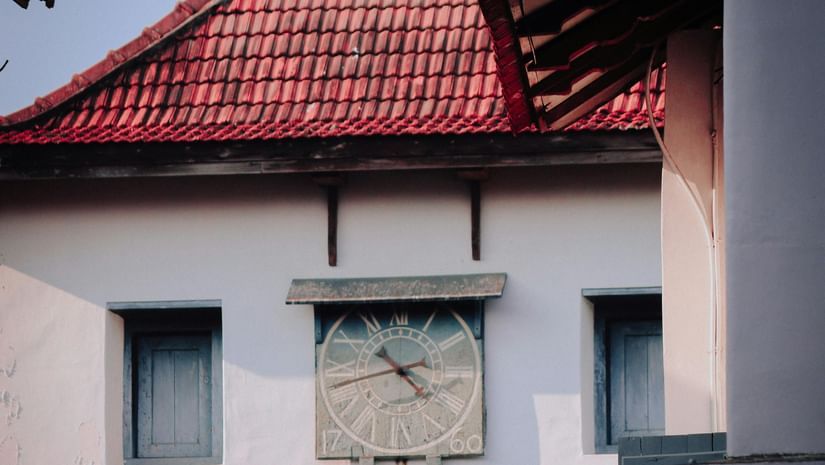
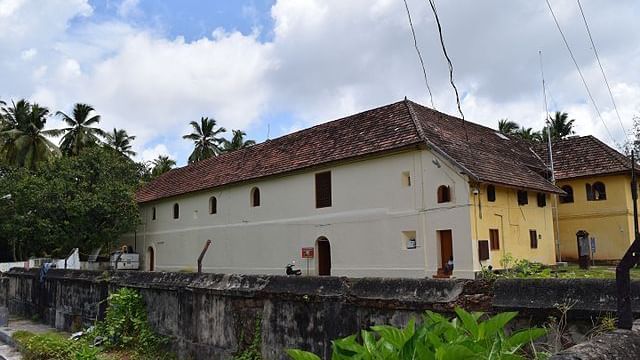
Kochi Mattancherry Palace – A Gift Across Kingdoms
The Mattancherry Palace history begins in the mid-16th century when the Portuguese built it as a gift to Veera Kerala Varma Raja, the King of Cochin. Under Dutch rule in the 17th century, the palace was extensively renovated, earning it the name “Dutch Palace.” Today, it is under the collaborative care of the Government of Kerala and the Archaeological Survey of India (ASI). It stands as a museum, preserving centuries of royal artefacts, art, and stories for future generations.
The Nalukettu Node of Kerala Architecture
The palace is a fine example of the Nalukettu, Kerala’s traditional quadrangular architecture, combined with subtle Dutch influences. Four wings surround a central courtyard that houses a temple dedicated to Pazhayannur Bhagavathy, with shrines to Shiva and Krishna on either side. Inside, visitors discover exquisite wood-carved floral ceilings, inverted lotus motifs, polished brass embellishments, and unique “black-marble” flooring made with coconut shell charcoal, lime, and egg whites.
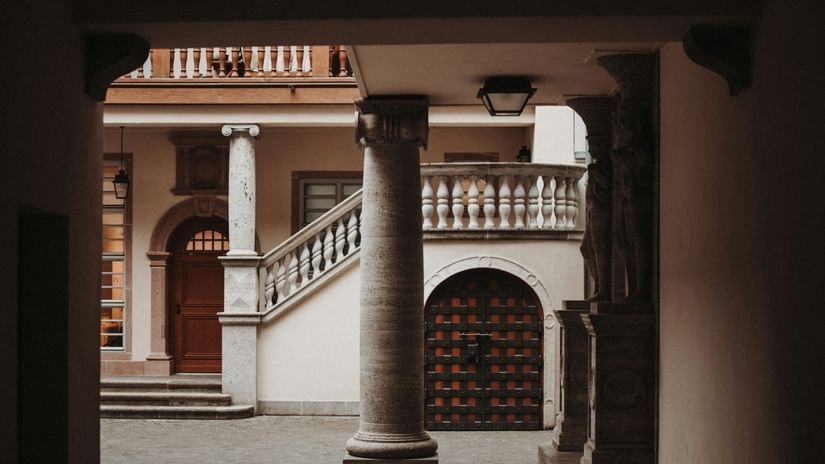
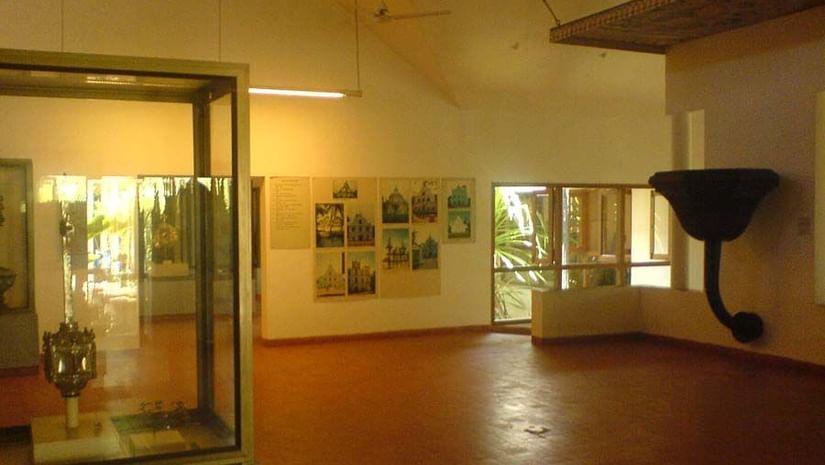
Kochi's Palatial Pride
The palace’s walls are adorned with grand murals depicting scenes from the Ramayana, Mahabharata, and Hindu legends, some covering more than 100 square meters. The royal bedchamber is a gallery of artistry, alongside displays of portraits of Cochin’s rulers since 1864. Ceremonial swords, palanquins, coins, royal umbrellas, and weapons add depth to its narrative. Declared a protected national monument in 1951, the palace saw extensive restoration by the Archaeological Survey of India in 2009.
Your Much-Needed Neemrana Retreat
Just about 3 km from the Dutch Palace, The Tower House by Neemrana Hotels offers travellers an opportunity to live amidst history. Once a 17th-century lighthouse tower, this Fort Kochi heritage hotel retains its colonial charm with high-ceilinged rooms, vintage furnishings, bathtubs and four-poster beds. Facing the iconic Chinese fishing nets, it offers a serene retreat with a pool, warm hospitality, and easy access to Kochi’s most celebrated heritage and tourist spots.
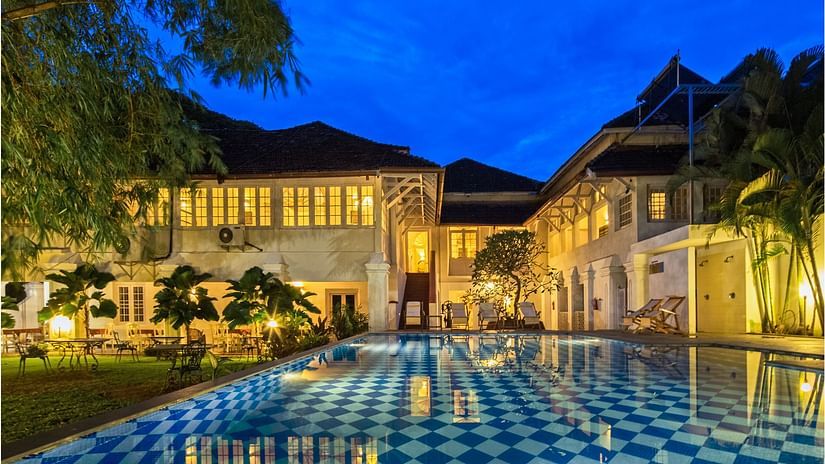
The Mattancherry Palace and The Tower House together offer more than history. They serve as living reminders of Kerala’s rich and layered past. While the palace tells tales of royal grandeur and cultural evolution, The Tower House allows travellers to stay wrapped in the elegance of another era. Together, they create an unforgettable journey through the heritage heart of Kochi.